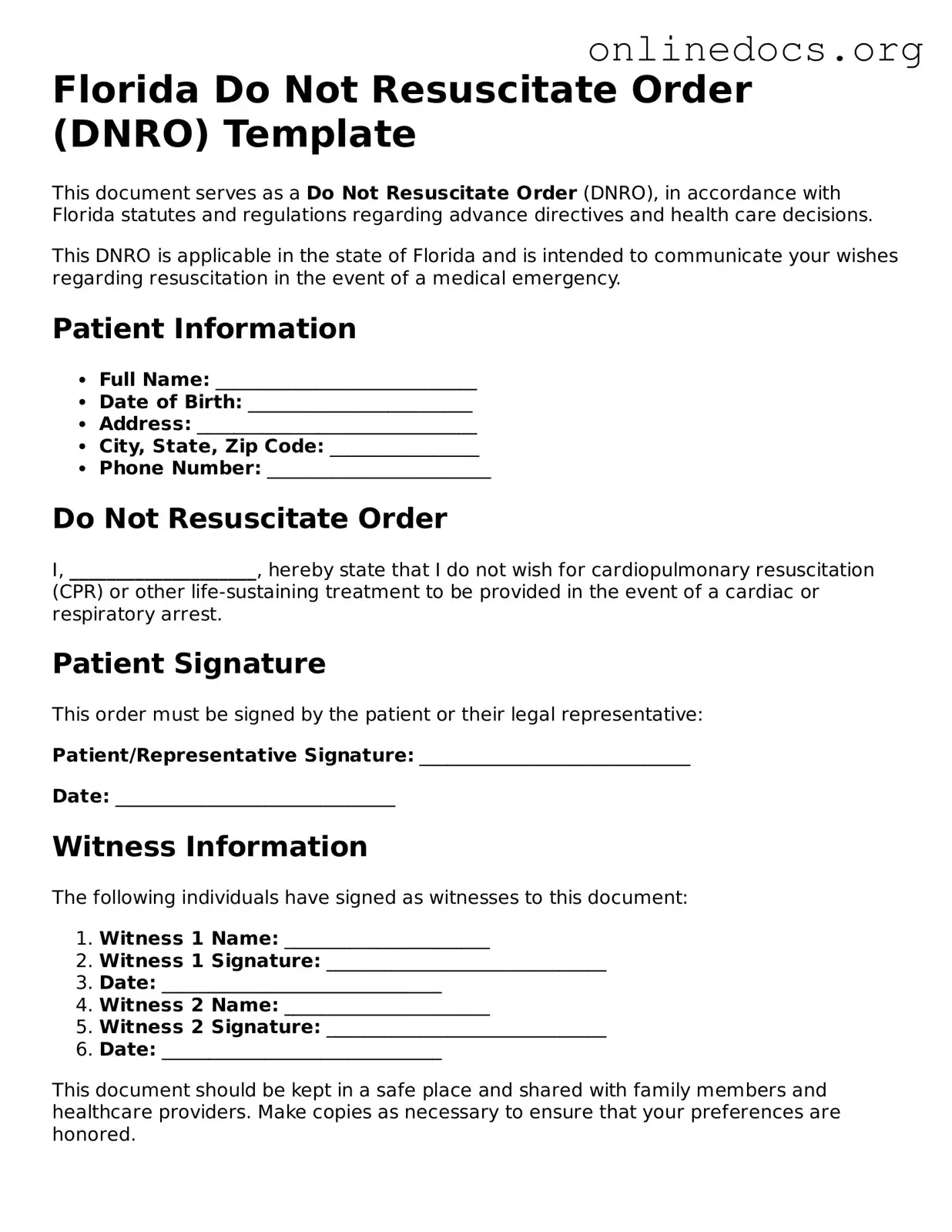The Florida Do Not Resuscitate Order (DNRO) form shares similarities with a Living Will. A Living Will is a legal document that allows individuals to outline their preferences regarding medical treatment in situations where they are unable to communicate their wishes. Both documents serve to express a person's desire to limit or refuse life-sustaining measures. While a DNRO specifically addresses the decision not to receive cardiopulmonary resuscitation (CPR), a Living Will encompasses a broader range of medical interventions, providing comprehensive guidance to healthcare providers and loved ones about an individual’s end-of-life care preferences.
Another document akin to the DNRO is a Healthcare Proxy or Medical Power of Attorney. This legal instrument designates a trusted person to make healthcare decisions on behalf of someone who is incapacitated. Like the DNRO, which communicates a specific medical wish, the Healthcare Proxy allows individuals to ensure that their healthcare preferences are respected when they cannot advocate for themselves. The key difference lies in the scope; while the DNRO is focused on resuscitation efforts, the Healthcare Proxy empowers the appointed individual to make various medical decisions based on the patient’s known wishes or best interests.
The Physician Orders for Life-Sustaining Treatment (POLST) form also resembles the DNRO in its intent to communicate a patient’s preferences regarding medical treatment. The POLST is designed for individuals with serious illnesses or advanced age, outlining specific medical interventions they wish to receive or avoid. Both the DNRO and POLST are actionable medical orders that healthcare providers must follow. However, the POLST is more comprehensive, addressing a wider array of treatments beyond resuscitation, ensuring that the patient’s overall treatment goals are honored.
Advance Directives are another related document that shares the essence of the DNRO. An Advance Directive is a broader category that includes both Living Wills and Healthcare Proxies. It serves as a way for individuals to express their healthcare preferences in advance, covering various scenarios, including end-of-life care. Like the DNRO, Advance Directives aim to guide medical professionals and family members in honoring a person’s wishes when they can no longer communicate those preferences. The flexibility of Advance Directives allows for a more holistic approach to planning for future healthcare needs.
A Do Not Intubate (DNI) order is closely related to the DNRO, as both documents address specific interventions that a patient may wish to refuse. A DNI specifically indicates that a patient does not want to be placed on a ventilator or have their airway artificially managed in the event of respiratory failure. While the DNRO focuses on the refusal of resuscitation efforts, the DNI complements it by addressing another critical aspect of life-sustaining treatment. Together, these orders help clarify a patient’s wishes regarding critical care interventions.
When considering important legal documents, it is crucial to understand the process of creating a comprehensive Last Will and Testament, as it provides clarity on asset distribution and guardianship for minor children. This form serves to convey personal wishes posthumously, ensuring that one's intentions are honored and family members are provided with guidance during a difficult time.
Lastly, the Medical Orders for Scope of Treatment (MOST) form is similar to the DNRO in that it provides specific instructions regarding a patient’s treatment preferences. The MOST form is utilized primarily in certain states and is designed for patients with serious health conditions. Like the DNRO, it allows individuals to communicate their wishes about resuscitation and other life-sustaining measures. The MOST form, however, typically includes more detailed options for treatment preferences, making it a valuable tool for ensuring that a patient’s desires are clearly understood and respected in various medical scenarios.
